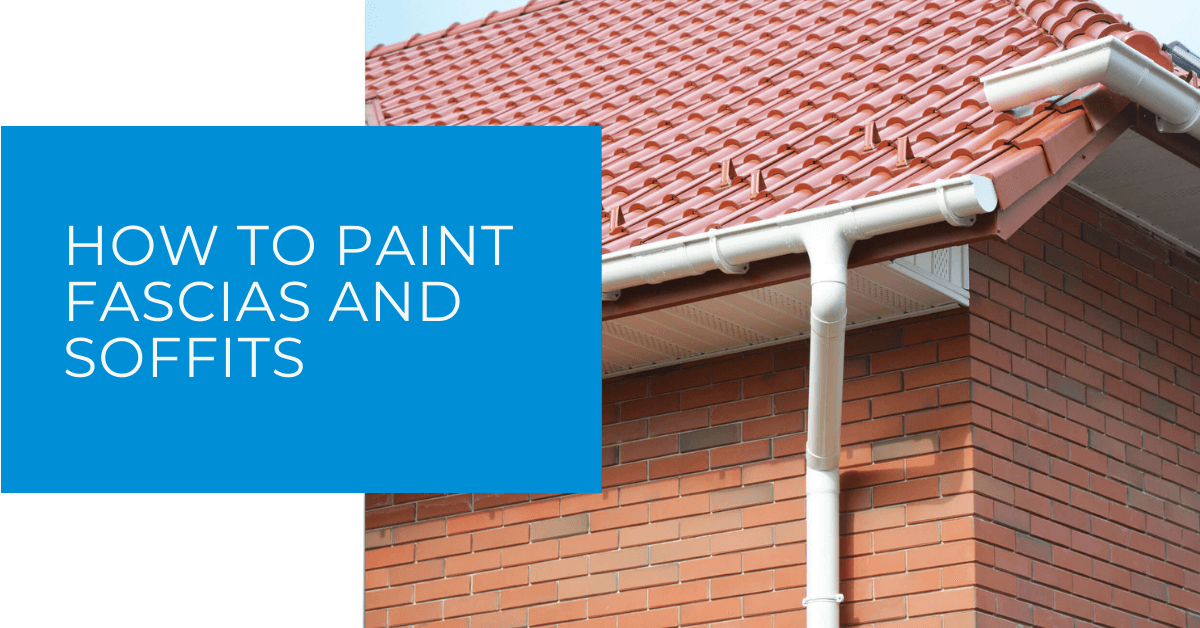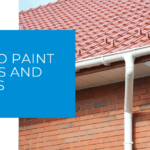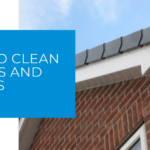Painting the fascia and soffits on your home is a great way to add curb appeal. It can also help prevent water damage, which is common in homes with these areas unpainted. These tips will show you how to paint them correctly and efficiently.
Contents
Tools Required for the Job
- Paintbrush
- Paint roller
- Extension ladder
- Lead paint scraper
- Household cleaner
- Tape measure
- Marker or pencil
Why Paint Your Fascias and Soffits?
The fascia and soffits are a critical part of your home’s exterior. They play an important role in protecting the roofing and guttering, and they can add aesthetic appeal to your home. Painting them is a great way to improve their appearance and protect them from damage.
Step by Step Guide to Painting Your Fascias and Soffits
 If your home has lead-based paint on the fascias and soffits, you will need to take some special precautions. Be sure to read about how to safely remove lead paint before beginning the project.
If your home has lead-based paint on the fascias and soffits, you will need to take some special precautions. Be sure to read about how to safely remove lead paint before beginning the project.
If your home is vinyl, you will need to use a primer designed for plastic surfaces.
You will also need some painter’s tape to protect any areas that you don’t want to be painted.
Step 1
Start by cleaning the surfaces you will be painting. Be sure to remove any dirt, dust, or debris. If there is any paint that is peeling or chipping, you will need to remove it before painting. You can do this with a lead paint scraper.
Step 2
Once the surfaces are clean, use a tape measure to mark where the edges of your house are. You will need to make sure that you cover all areas under these marks with tape before painting.
Step 3
It is also wise to create a tarp or drop cloth by covering any surfaces near your paintwork area, like your lawn and driveway. If there is wind, this can help protect it from getting wet too quickly as well as prevent dust or debris from landing on wet paint. Be careful when working around plants though because they may be damaged if they get painted over accidentally.
Step 4
Next, use a brush for tight spots like corner trim boards and window casings where the roller won’t fit easily. Then roll on an even coat over large flat sections using gentle strokes in the direction of the wood grain.
If you have a small section that is difficult to reach with the paint roller, use a brush instead. Do this for any tight spots or areas where there are multiple angles and corners as well as places like window sills and corner boards.
Step 5
Be sure to wait at least 24 hours before removing the painter’s tape from around your home’s edges, which will protect against drips of color touching these parts unintentionally. Once it has dried completely (usually within 48 hours), remove all tape carefully so that you don’t damage any new paint underneath it.
What Are Fascias and Soffits?
The fascias and soffits are a part of the roofline that is often left unpainted. They play an important role in protecting your home from water damage by keeping the roofing and guttering in good condition.
The fascias are usually a horizontal board that runs along the edge of the roof, while the soffits are located under the eaves and extend down to cover the top half of the windows. Painting them can improve their appearance and help keep them in good condition for years to come.
Common Mistakes When Painting the Fascias or Soffits
- Not cleaning the surface properly before painting. This can cause the paint to peel or chip off quickly.
- Not using a primer if your home is vinyl. This can cause the paint to fade and chip over time.
- Painting in direct sunlight. The sun can cause the paint to dry too quickly, which can lead to uneven coverage or drips.
- Using a roller when it’s not necessary. A brush should be used for tight spots and areas with multiple angles and corners.
- Not waiting long enough for the paint to dry before removing tape from around edges. If you remove the tape too soon, it could pull off some of the new paint underneath. Wait at least 48 hours for the paint to completely dry before removing the tape.
- Not using a primer if your home is vinyl. This can cause the paint to fade and chip over time.
- Painting in direct sunlight. The sun can cause the paint to dry too quickly, which can lead to uneven coverage or drips.
- Using a roller when it’s not necessary. A brush should be used for tight spots and areas with multiple angles and corners.
Benefits of Painting Fascias and Soffits
- Improve your home’s appearance
- Protect it from water damage
- Make maintenance easier in the future. Painting over existing paint is much easier than removing all of it and starting with a clean surface. Some paints can also last up to 30 years if properly maintained and cared for after painting, which makes them very cost-effective as well!
- Improve your home’s appearance. Painting fascias and soffits will make your house look better on the inside, especially since they are often neglected until they become an eyesore or start peeling off completely. It could even increase the value of your home when you’re ready to sell because many buyers want their homes’ exterior looking nice before moving into them. The paint will also protect your home from any water damage that could be caused by worn-out or broken boards, which makes it much easier to maintain and care for in the future.
- Make maintenance easier in the future. Painting over existing paint is much easier than removing all of it and starting with a clean surface. Some paints can also last up to 30 years if properly maintained and cared for after painting, which makes them very cost-effective as well!
Painting Fascias and Soffits FAQs
Is it better to paint them all at once or do a little bit each time?
 You can choose whether you want to paint the entire fascias and soffits before removing your painter’s tape, which will protect against drips of color touching these parts unintentionally. Or you could start painting near one edge and move inwards until they are completely painted.
You can choose whether you want to paint the entire fascias and soffits before removing your painter’s tape, which will protect against drips of color touching these parts unintentionally. Or you could start painting near one edge and move inwards until they are completely painted.
Either way is fine as long as there is plenty of drying time between coats because if any wet spots touch another area that has already dried, this can cause problems with peeling or chipping later on down the line.
Can I use an airless sprayer instead?
It may be possible depending on what type of machine you have access too but usually spraying takes much less time than brushing or rolling so it may not be the best option in this case.
What type of paint should I use?
Latex or oil-based paints can both be used but latex is generally a better choice because it’s easier to work with, doesn’t have a strong odor, and is more affordable. You will also need to choose a sheen level (e.g. matte, eggshell, semi-gloss). A higher sheen provides more protection against water and dirt but may show every little flaw on the surface.
Can I just use a brush?
If you have a small section that is difficult to reach with the paint roller, use a brush instead. Do this for any tight spots or areas where there are multiple angles and corners. Be sure to use a good quality brush with synthetic bristles so that it doesn’t shed as you’re painting.
Can I paint them the same color as my trim?
You can, but be aware that this may make your home look too monochromatic. A better option might be to choose a slightly different shade or even a contrasting color to add visual interest. -I have vinyl siding on my house.
Should I use a primer?
If your home has vinyl siding, it’s important to use a primer before painting the fascias and soffits because latex paints will not adhere well to this surface type.
Primers help create a stronger bond between the paint and the substrate which will help to prevent fading and chipping over time.
Can I just use a paint sprayer?
If you have access to an airless sprayer, it’s definitely the fastest way to get the job done. However, be aware that spraying can cause overspray which could end up on windows or other surfaces that you don’t want to be painted. It’s also important to take care not to apply too much pressure or you may end up with drips or runs in your finish coat.
Do I need to wait for the paint to dry before removing the tape?
Yes! Make sure that the paint is completely dry (usually 48 hours) before removing any painter’s tape from around the edges. If you remove it too soon, you could pull off some of the fresh paint with the tape.
What if I make a mistake?
If you do make a mistake, don’t worry! Just wait for the paint to dry completely and then sand it down lightly before starting over. Be sure to clean off any sanding dust before applying another coat.
Final Thoughts on Painting Fascias and Soffits
Painting fascias and soffits can be a great way to improve the look of your home and add some extra protection against the elements. It’s important to choose the right type of paint, primer, and tools for the job, but with a little bit of preparation, it can be a quick and easy process. Follow these tips and you’ll have beautiful new trim in no time!






